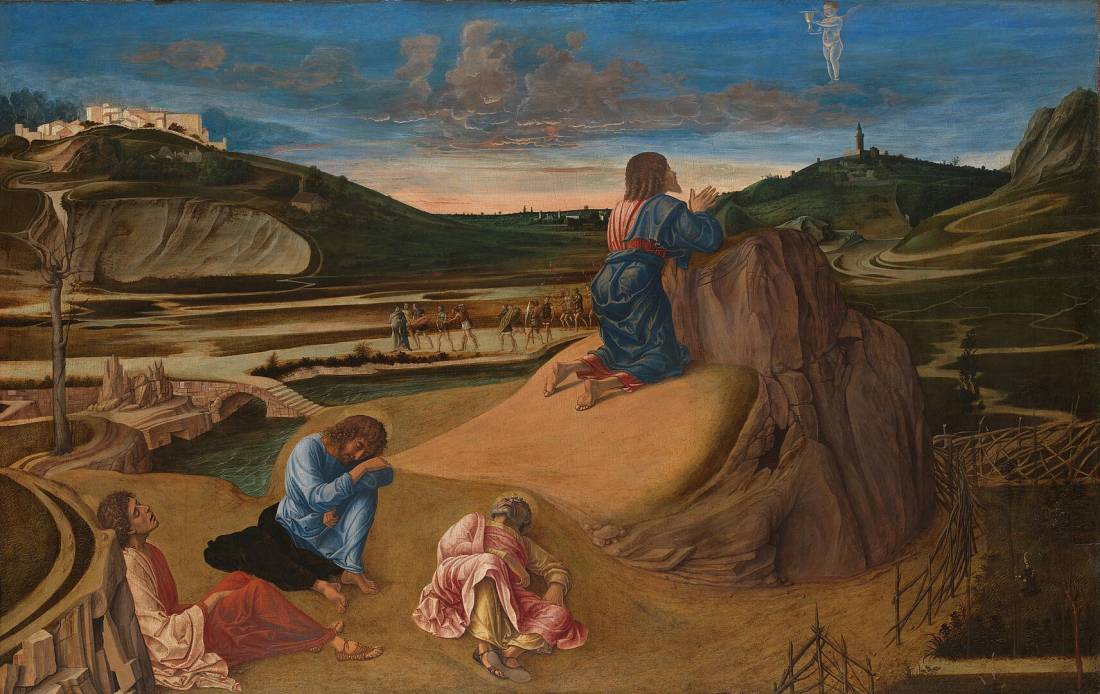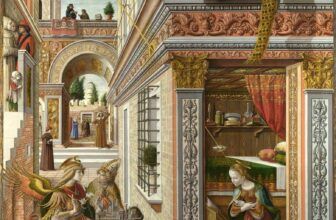
The Agony in the Garden, Giovanni Bellini: Story and Meaning
Among the treasures of Renaissance painting, Giovanni Bellini’s Agony in the Garden stands out as one of the most moving and spiritually profound. Painted around 1458–1465, this work demonstrates the young Bellini’s ability to fuse narrative, symbolism, and atmosphere into a unified vision that transcends time. It is a deeply meditative piece that brings together theology, landscape painting, and human emotion, creating not only a devotional artwork but also a turning point in the history of Venetian Renaissance art.
The painting depicts a pivotal episode from the Gospels: Christ’s agony in the Garden of Gethsemane on the night before His crucifixion. Bellini interprets this narrative with a level of spiritual tenderness and poetic lyricism that both reflects his era and foreshadows the naturalism of Venetian painting that would later flourish under artists like Giorgione and Titian.
This essay explores the story behind Bellini’s Agony in the Garden, the context in which it was painted, its symbolism and meaning, its stylistic elements, and where it resides today. By doing so, we can appreciate not only its religious significance but also its lasting contribution to the history of art.
The Biblical Story of the Agony in the Garden
The subject of the painting comes from the New Testament, specifically the Gospels of Matthew, Mark, Luke, and John. The episode takes place shortly after the Last Supper. Jesus, knowing that His arrest, trial, and crucifixion are imminent, withdraws to the Garden of Gethsemane on the Mount of Olives to pray.
According to the Gospels, Christ experiences deep anguish, asking His disciples Peter, James, and John to stay awake and keep watch with Him. However, overwhelmed by fatigue, they fall asleep. Alone in prayer, Christ petitions God the Father: “Father, if it is possible, let this cup pass from me; yet not as I will, but as you will.”
This moment, often described as the “Agony in the Garden,” represents Christ’s human vulnerability and divine submission. An angel appears to comfort Him, and soon after, Judas arrives with soldiers to betray Him with a kiss.
Artists across centuries have been drawn to this theme because of its combination of human suffering, divine obedience, and foreshadowing of the Passion. Bellini’s interpretation is among the most significant of the Renaissance era.
Who Was Giovanni Bellini?
Giovanni Bellini (c. 1430–1516) was one of the most influential Venetian painters of the Renaissance. He came from a family of artists, his father Jacopo Bellini was a painter, and his brother Gentile was also well-known. Giovanni, however, would surpass them both, helping to establish Venice as a center of Renaissance art.
Bellini’s early works were influenced by the Gothic style and by the art of his brother-in-law, Andrea Mantegna, who favored strong linear perspectives and sculptural forms. Over time, Bellini developed a softer, more atmospheric style, embracing oil paints and natural light to create poetic landscapes and deeply emotional religious scenes.
The Agony in the Garden belongs to Bellini’s early career and reflects both Mantegna’s influence and Bellini’s emerging originality.
How and When the Agony in the Garden Was Painted
Scholars date Bellini’s Agony in the Garden to around 1458–1465. It was painted in tempera on panel, a medium typical before oil paints became widespread in Italy. The commission is not fully documented, but the painting was likely created for private devotion rather than a public altar.
What makes this painting especially fascinating is that Bellini appears to have been inspired by his brother-in-law Andrea Mantegna, who painted his own Agony in the Garden around the same time. Both paintings share compositional similarities: Christ praying on a rocky outcrop, the disciples asleep, and soldiers approaching in the distance. However, Bellini’s version transforms Mantegna’s rigid, sculptural approach into something more lyrical and naturalistic.
The painting shows Bellini experimenting with perspective, space, and landscape. Unlike earlier Gothic depictions, where the background was symbolic or flattened, Bellini fills the scene with rolling hills, winding paths, rivers, and a luminous sky. This integration of narrative and landscape became a hallmark of Venetian art.
What the Agony in the Garden Painting Represents
Bellini’s Agony in the Garden represents the tension between human weakness and divine destiny. It is a meditation on suffering, faith, and obedience.
Christ’s Prayer: The central figure of Christ kneels on a rocky ledge, gazing upward in prayer. His posture is both humble and resolute, symbolizing His acceptance of God’s will.
The Sleeping Apostles: At the lower left, the disciples Peter, James, and John lie asleep, symbolizing human frailty and spiritual negligence. Their slumber contrasts with Christ’s wakefulness and readiness.
The Approaching Soldiers: In the background, Judas leads a group of soldiers across a bridge, foreshadowing Christ’s betrayal and arrest. This detail ties the immediate moment of prayer to the unfolding narrative of the Passion.
The Landscape: The vast, luminous landscape enveloping the figures transforms the biblical episode into a meditation on the natural and divine order of the world.
The painting represents not just a historical event but a timeless spiritual struggle, the agony of confronting suffering and mortality while embracing faith and redemption.
Symbolism and Meaning of Agony in the Garden
Bellini’s painting is rich in symbolism, carefully woven into the composition:
Christ on the Rock: Christ kneels on a jagged outcrop, symbolizing His role as the cornerstone of faith and the firmness of His resolve. The rock also alludes to Peter, the “rock” of the Church, who at this moment is asleep.
The Cup of Suffering: Though not explicitly depicted in this version, the “cup” mentioned in the Gospels is suggested by Christ’s upward gaze, symbolizing His acceptance of the burden of humanity’s sins.
The Angel: In some versions of the theme, an angel is shown offering comfort to Christ. Bellini omits the angel here, perhaps to emphasize Christ’s solitude and the depth of His human agony.
The Sleeping Apostles: Their sleep is not merely physical but spiritual, a symbol of the weakness of mankind, unable to remain vigilant even in the hour of crisis.
The Path and Bridge: The winding road and bridge in the background symbolize the passage from innocence to betrayal, from prayer to passion, from life to death.
Light and Landscape: The transition from darkness to dawn symbolizes the movement from despair to hope, from suffering to redemption. The soft Venetian light suggests divine grace permeating the world.
The Soldiers: Judas and the soldiers in the distance embody betrayal, violence, and worldly power, drawing near even as Christ prays. Their small scale compared to the landscape suggests that their actions, though brutal, are dwarfed by the divine plan.
What Is Happening in the Agony in the Garden Painting
The painting captures a single moment rich with tension:
Christ prays alone, anticipating His Passion.
The disciples, despite His request, are asleep nearby.
In the far distance, Judas approaches with soldiers.
This layering of time, the immediate moment of prayer, the disciples’ failure, and the foreshadowing of betrayal, creates a narrative within a single image. The viewer is invited to meditate on the unfolding events and their spiritual significance.
Agony in the Garden, Style and Type of Art
Bellini’s Agony in the Garden belongs to the early Renaissance period and represents a transitional moment in Venetian painting. Its features include:
Medium: Tempera on panel, typical of the mid-15th century.
Influence: Strong influence from Mantegna, especially in composition and use of perspective, but softened with Bellini’s lyrical style.
Landscape Integration: A major innovation lies in the naturalistic landscape, which is not a backdrop but an active participant in the scene.
Atmosphere: Bellini begins to explore light and atmosphere, anticipating the Venetian school’s later achievements in oil painting.
Religious Devotion: The painting was likely intended for private contemplation, inviting viewers into the emotional and spiritual drama of Christ’s Passion.
Thus, the painting is both a devotional work and a milestone in the development of Renaissance art.
Agony in the Garden Location Today
Giovanni Bellini’s Agony in the Garden is housed in the National Gallery in London, one of the world’s premier collections of European art. It entered the museum in the 19th century and remains a highlight of the Renaissance galleries.
The National Gallery’s display allows viewers to compare Bellini’s work with that of his contemporaries, including Mantegna’s own Agony in the Garden, which the museum also owns. Together, these works illustrate the dialogue between artists and the evolution of Renaissance painting.
Bellini’s Contribution Through This Painting
The significance of Agony in the Garden lies not only in its religious meaning but also in its role in shaping Renaissance art:
Fusion of Landscape and Devotion: Bellini pioneered the integration of expansive, poetic landscapes into religious narrative, a hallmark of Venetian painting.
Human Emotion: He emphasized Christ’s humanity, His solitude, vulnerability, and acceptance, making the spiritual more relatable.
Transition to Atmosphere: Bellini’s attention to light, air, and atmosphere anticipated the Venetian love of color and mood.
Dialogue with Mantegna: The comparison with Mantegna’s version shows Bellini moving from rigid perspective to softer lyricism, defining the Venetian style against the Paduan.
Giovanni Bellini’s Agony in the Garden is far more than a simple retelling of a biblical episode. It is a meditation on suffering, faith, and redemption, expressed through a harmonious blend of narrative, symbolism, and natural beauty.
The painting captures the profound tension of the moment: Christ’s divine submission versus human weakness, the stillness of prayer versus the approach of violence, the darkness of night yielding to dawn. Bellini’s luminous landscape becomes a metaphor for hope and transcendence, enveloping the figures in divine light.
As one of Bellini’s earliest masterpieces, the work reveals his genius for combining spirituality with naturalism, laying the foundations for the Venetian Renaissance. Today, housed in the National Gallery in London, it continues to inspire viewers with its quiet power and timeless beauty.
Ultimately, Bellini’s Agony in the Garden is a visual sermon: a call to contemplate human frailty, divine grace, and the eternal balance between suffering and salvation.




